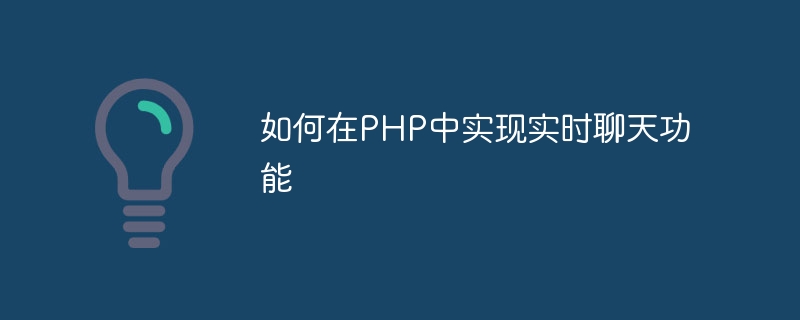Home >Backend Development >PHP Tutorial >How to implement real-time chat functionality in PHP
How to implement real-time chat functionality in PHP
- 王林Original
- 2023-09-24 16:49:511772browse

How to implement real-time chat function in PHP
With the popularity of social media and instant messaging applications, real-time chat function has become a standard feature of many websites and applications. In this article, we will explore how to implement live chat functionality using PHP language, along with some code examples.
- Using WebSocket Protocol
Live chat functionality usually requires the use of the WebSocket protocol, which allows two-way communication between the server and the client. In PHP, we can use the Ratchet library to implement a WebSocket server.
First, we need to use Composer to install the Ratchet library:
composer require cboden/ratchet
Next, we can create a PHP file to implement the WebSocket server:
<?php
require_once 'vendor/autoload.php';
use RatchetMessageComponentInterface;
use RatchetConnectionInterface;
class Chat implements MessageComponentInterface {
protected $clients;
public function __construct() {
$this->clients = new SplObjectStorage;
}
public function onOpen(ConnectionInterface $conn) {
$this->clients->attach($conn);
echo "New connection! ({$conn->resourceId})
";
}
public function onMessage(ConnectionInterface $from, $msg) {
foreach ($this->clients as $client) {
if ($client !== $from) {
$client->send($msg);
}
}
}
public function onClose(ConnectionInterface $conn) {
$this->clients->detach($conn);
echo "Connection {$conn->resourceId} has disconnected
";
}
public function onError(ConnectionInterface $conn, Exception $e) {
echo "An error has occurred: {$e->getMessage()}
";
$conn->close();
}
}
$server = RatchetServerIoServer::factory(
new RatchetHttpHttpServer(
new RatchetWebSocketWsServer(
new Chat()
)
),
8080
);
$server->run();The above code creates a class named Chat, which implements the MessageComponentInterface interface for handling WebSocket communication. The onOpen() function will be called when a new connection is established, the onMessage() function will be called when a message is received, the onClose() function will be called when the connection is closed, and the onError() function will be called when an error occurs. In the onMessage() function, we loop through all clients and send the message to other clients except the sender.
After running the above code, the WebSocket server will start listening on port 8080. Below we will discuss how to communicate with the server using JavaScript.
-
Communicate using JavaScript
In JavaScript code, we can use WebSocket objects to communicate with the server. The following is a simple example:<!DOCTYPE html> <html> <head> <title>实时聊天</title> </head> <body> <input type="text" id="message" placeholder="输入消息"> <button onclick="send()">发送</button> <div id="output"></div> <script> var socket = new WebSocket("ws://localhost:8080"); socket.onopen = function() { console.log("连接已建立"); } socket.onmessage = function(event) { var message = event.data; document.getElementById("output").innerHTML += "<p>" + message + "</p>"; } socket.onclose = function() { console.log("连接已关闭"); } function send() { var message = document.getElementById("message").value; socket.send(message); } </script> </body> </html>
The above code creates a WebSocket object and specifies the server address to connect to. When the connection is established, the onopen function will be called. When a message is received, the onmessage function outputs the received message on the page. When the connection is closed, the onclose function will be called.
Now, we have completed the basic steps of implementing live chat functionality using PHP. When the user enters a message in the input box and clicks the send button, the message is sent to the server via WebSocket and broadcast to all connected clients.
Summary:
This article introduces how to use PHP to implement real-time chat functionality and provides some code examples. By using WebSocket protocol and Ratchet library, we can implement simple and efficient real-time chat functionality in PHP. Hope this article can be helpful to you!
The above is the detailed content of How to implement real-time chat functionality in PHP. For more information, please follow other related articles on the PHP Chinese website!

